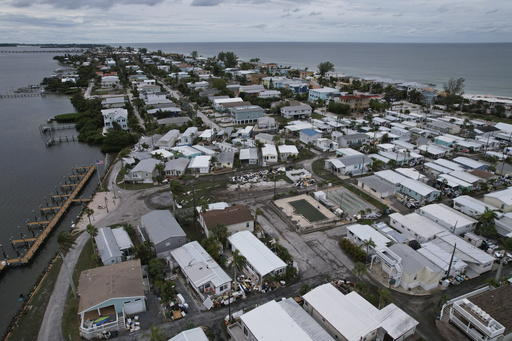TALLAHASSEE, Fla. — Just a fortnight ago, Hurricane Helene narrowly missed the Tampa Bay region, yet the resulting storm surge still wreaked havoc, flooding homes, causing fatalities among those who chose to remain near the coastline, and creating significant debris accumulations along local roads.
Now, as Hurricane Milton, a more intense storm, approaches this same area, residents are left wondering what to anticipate.
“Much worse,” warns Craig Fugate, a former head of the Federal Emergency Management Agency and a long-time Florida resident who previously directed the state’s emergency management efforts.
Communities surrounding Tampa Bay experienced unprecedented storm surge levels during Helene, despite the storm making landfall over 100 miles to the north. Meteorologists now predict that this vulnerable region may face a staggering storm surge of up to 15 feet (5 meters).
“This isn’t water that rises slowly. It’s fast-moving and comes with waves—like a battering ram,” Fugate explained. “Being in that area is extremely dangerous. Many lives were lost in situations where individuals did not evacuate in time. They drowned or were crushed when their homes collapsed.”
**Understanding Storm Surge**
Storm surge refers to the abnormal rise in sea level due to storms, going beyond the typical tidal levels. It’s important to understand that while storm winds can be measured, often there are stronger gusts not included in standard evaluations. Similarly, the wave heights above the baseline water level are not calculated into the surge itself.
The surge signifies how much the water level exceeds the regular tide, meaning that a 15-foot (5-meter) storm surge occurring at high tide and combined with 10-foot (3-meter) waves can easily demolish buildings, uproot bridges, and clear a path of destruction.
**Potential Effects on Florida’s Western Coast**
The Tampa Bay area, located along Florida’s western coast, is not the only community facing risks; St. Petersburg and the crowded barrier islands also lie close to the Gulf of Mexico. The threat of storm surge stretches 150 miles (241 kilometers) north into the Big Bend area and south to Naples, extending into the Florida Keys.
Regardless of Milton’s landfall location, the storm is projected to have a substantial impact. However, the highest surge levels will likely occur south of Milton’s center, which could include the Tampa Bay area and its 3.3 million residents, posing dangerous flooding risks. It’s worth noting that this region has not experienced a direct hit from a significant hurricane in over a century.
Should the storm make landfall south of Tampa Bay, cities like Sarasota, Venice, Fort Myers, and Naples may experience catastrophic outcomes, just two years following Hurricane Ian’s devastating impact, which swept away homes and rendered bridges to barrier islands unusable.
**What About the Debris Left by Helene?**
State and local authorities are mobilizing efforts to clear away tree branches, furniture, appliances, and other remains left in massive piles after Helene. However, not all debris will be removed in time.
With concerns about Milton’s winds and surges transforming leftover debris into hazardous projectiles, Fugate stressed the importance of evacuating. Property damage will be severe whether or not debris is airborne.
“I have a sense that everything still standing will become debris, blending into the surroundings,” he noted. “If the water is powerful enough to relocate those items, it’s also going to move homes, vehicles, and more.”
**Could Milton Weaken Before Impact?**
While it is possible for Milton to downgrade from a Category 5 storm to a Category 3, such a weakening may not significantly affect the storm surge.
“Wind doesn’t have memory, but storm surge does,” highlighted Fugate. “What happens with a storm leading up to its landfall plays a crucial role in determining surge levels. Once energy is transferred into the water, a decline in storm strength won’t greatly alter the situation.”
Moreover, the area heading into Milton is crisscrossed with numerous creeks, canals, and rivers, which could exacerbate issues well beyond the coastline.
“This type of storm tends to mislead many people, who focus too much on its category and trajectory instead of heeding local weather services and the hurricane center’s warnings about potential impacts,” Fugate advised. “The threat of storm surge is not solely linked to wind strength; it operates independently.”
